Transcription of Vectra - Hi Polymers
1 Vectra liquid crystal polymer (LCP). VC-7. high melt flow, easily fills long, thin complicated flow paths with minimal warpage heat deflection up to 300 C. high mechanical strength excellent dimensional stability fast cycling inherently flame retardant excellent organic liquid crystal polymer (LCP). solvent resistance wide processing window . Vectra Vectra . liquid crystal polymer (LCP). Table of Contents 1. Introduction and Overview 9. 2. Vectra LCP Product Line 12. Grade Description 12. Glass fiber reinforced grades (100-series) 12. Carbon fiber reinforced grades (200-series) 12. Filler/fiber combinations (400-series) 12. Mineral filled grades (500-series) 12. Graphite filled grades (600-series) 12. Specialty grades (700 and 800-series) 12. Colors 14. Packaging 14. 3. Physical Properties 15. Mechanical properties 16. Effect of anisotropy and wall thickness 16. Short term stress 18. Behavior under long term stress 19. Notch sensitivity (Impact testing) 20. Fatigue 20.
2 Tribological properties 21. Damping 21. Thermal properties 22. Dynamic mechanical spectra 22. Deflection temperature under load 24. Coefficient of linear thermal expansion 24. Soldering compatibility 26. Thermodynamics, phase transition 26. Flammability and combustion 28. Electrical properties 29. Regulatory Approvals 33. Food and Drug Administration 33. United States Pharmacopoeia 33. Biological Evaluation of Medical Devices (ISO 10993) 33. Underwriters Laboratories 33. Canadian Standards Association 33. Water Approvals Germany and Great Britain 33. 4. Environmental Effects 34. Hydrolysis 34. Chemicals and solvents 35. Permeability 37. Radiation resistance 37. Ultraviolet and weathering resistance 37. 2. Vectra . liquid crystal polymer (LCP). Introduction and Overview 1. 5. Processing 39. Safety considerations 39. Vectra LCP. Start up and shutdown procedures 39. Product Line 2. Fire precautions 40. Drying 40. 6. Injection Molding 41 Physical Properties 3. Equipment selection 41.
3 General 41. Screw design 41. Environmental Check ring 41. Effects 4. Nozzle 42. Hot runner systems 42. Injection molding processing conditions 43. Melt temperature 43. Injection velocity 43 Processing 5. Mold temperature 43. Screw speed 43. Backpressure 43. Injection Screw decompression 43. Molding 6. Injection pressure 44. Holding pressure 44. Cycle time 44. Regrind 44. General recommendations 44 Extrusion 7. Equipment 45. Using regrind 45. Troubleshooting 45. Brittleness 45. Rheology 8. Burn marks 46. Dimensional variability 46. Discoloration 46. Flashing 46. Jetting 46 Design 9. Leaking check ring 46. Nozzle problems 46. Short shots 46. Secondary Sinks and voids 46. Operations 10. Sticking 47. Surface marks and blisters 47. Warpage and part distortion 47. Weld lines 47 Conversion Tables 11. 7. Extrusion 48. Equipment selection 48. General 48. Index 12. Screw design 48. 3. Vectra . liquid crystal polymer (LCP). Screen pack 48. Head and die 48. Melt pump 48. Processing 49.
4 Film and sheet 49. Profiles 49. Pipe and tubing 50. Overcoating 50. Troubleshooting 50. General extrusion 50. Pipe and tubing 51. Profiles 51. Film and sheet 51. Overcoating 51. 8. Rheology 52. 9. Design 53. Part design 53. Nominal wall thickness 53. Flow length and wall thickness 53. Shrinkage 54. Draft angle 54. Warpage 54. Weld lines 54. Ribs, corners, radii 55. Holes and depressions 55. Latches, snapfits, interference fits 55. Mold design 56. Mold material 56. Mold Finish 56. Runner systems 56. Gate location 57. Gate size 57. Gate design 57. Submarine (tunnel) gates 57. Pin gates 59. Film (fan) gates 59. Ring and diaphragm gates 59. Overflow gates 59. Vents 59. Ejection 60. 10. Secondary Operations 61. Annealing 61. Assembly 61. Welding 61. Ultrasonic welding 61. Rotational (spin) welding 62. Hot plate welding 62. Vibration welding 63. Electromagnetic welding 63. 4. Vectra . liquid crystal polymer (LCP). Hot and cold staking 63. Adhesive bonding 64. Fasteners 66 Introduction Screws 66 and Overview 1.
5 Ultrasonic inserts 66. Decoration 66. Printing 66. Vectra LCP. Painting 67. Product Line 2. Laser marking 68. Metallization and Molded Interconnect 68. Devices (MID). Machining 70 Physical Prototype machining 70 Properties 3. Tooling 71. Turning 71. Milling and drilling 71. Environmental Threading and tapping 71. Effects 4. Sawing 71. 11. Conversion Tables 72. Unit conversion factors 72 Processing 5. Tensile or flexural property conversion 72. Length conversion 72. Temperature conversion 72. Injection Molding 6. 12. Index 73. Extrusion 7. Rheology 8. Design 9. Secondary Operations 10. Conversion Tables 11. Index 12. 5. Vectra . liquid crystal polymer (LCP). List of Tables Table Comparison of Amorphous, Semi- 9. Crystalline and Liquid Crystalline Polymers Table Key Performance Characteristics by 10. Market Table Available Color Master Batches 14. Table Anisotropy of Properties 2 mm thick 16. Table Anisotropy of Properties 1 mm thick 16. Table Coefficient of Friction, , of Vectra LCP (ASTM D1894) 21.
6 Table Dynamic Mechanical Analysis 23. Table Coefficient of Linear Thermal Expansion (-50 to 200 C) 25. Table Vapor Phase Soldering Stability of Vectra LCP 26. Table Soldering Compatibility of Vectra LCP 26. Table Smoke Density of Vectra A950 28. Table Products of Combustion of Vectra A950 28. Table Heat Release of Vectra A950 28. Table Underwriters Laboratories Listing for Vectra LCP 29. Table Vectra LCP Conductive Grades 29. Table Electrical Properties of As-Molded/. Un-Plated Vectra LCP 30. Table Electrical Properties of Gold Plated Vectra LCP 30. Table Chemical Resistance 35. Table Permeability of Various Polymer Films 38. Table Hydrogen Permeability 38. Table Cobalt 60 Radiation Vectra A950 38. Table Results of Artificial Weathering for 2,000 hours 38. Table Partial Listing of Potential Mold Steels 58. Table Electromagnetic Welding Strengths 63. Table Lap Shear Strength 65. Table Typical Adhesives for Vectra LCP 65. Table Adhesives Compliant with US Regulations 66. Table Lap Shear Strengths 66.
7 Table Typical Boss Dimensions 66. Table EJOT PT K Screw 67. Table Performance of Molded-in Inserts 67. Table Tool Speeds for Drilling or Milling 71. 6. Vectra . liquid crystal polymer (LCP). List of Figures Introduction Fig. Representation of the Structural and Overview 1. Differences Between Liquid Crystal Polymers and Conventional Semi- Crystalline Polymers 9. Vectra LCP. Fig. Price Performance Comparison of Product Line 2. Engineering and High Performance Plastics 11. Fig. Vectra LCP Product Line 13. Fig. Fracture Surface of Unfilled Vectra LCP 15 Physical Fig. Comparison of Anisotropy of Vectra Properties 3. LCP versus PBT 16. Fig. Micrograph of Fiber Structure showing Orientation of Outer Layers 16. Environmental Fig. Tensile Modulus versus Wall Thickness 17. Effects 4. Fig. Tensile Strength versus Wall Thickness 17. Fig. Flexural Modulus versus Wall Thickness 17. Fig. Flexural Strength versus Wall Thickness 17. Fig. Stress Strain Curves at 23 C 18. Fig. a) Influence of Temperature on Stress Processing 5.
8 Strain Behavior, Vectra B230. b) Influence of Temperature on Stress Strain Behavior, Vectra E130i 18. Injection Fig. Tensile Modulus versus Temperature 18. Molding 6. Fig. Tensile Strength versus Temperature 19. Fig. Tensile Creep Modulus, Vectra E130i 19. Fig. Tensile Creep Modulus, Vectra H140 19. Fig. Flexural Creep Modulus, Vectra A130 19. Fig. Flexural Creep Modulus, Vectra B130 20 Extrusion 7. Fig. Flexural Creep Modulus, Vectra C130 20. Fig. Stress Ranges in Fatigue Tests 20. Fig. W hler Curves for Vectra 20. Fig. Friction and Wear 21. Rheology 8. Fig. Damping Properties 22. Fig. Vibration Characteristics 22. Fig. Dynamic Mechanical Analysis, Vectra A130 23. Fig. Dynamic Mechanical Analysis, Design 9. Vectra A530 23. Fig. Dynamic Mechanical Analysis, Vectra B130 23. Secondary Fig. Dynamic Mechanical Analysis, Operations 10. Vectra B230 23. Fig. Dynamic Mechanical Analysis, Vectra E130i 23. Fig. Dynamic Mechanical Analysis, Conversion Vectra E530i 24 Tables 11. Fig.
9 Dynamic Mechanical Analysis, Vectra H140 24. Fig. Dynamic Mechanical Analysis, Vectra L130 24. Index 12. 7. Vectra . liquid crystal polymer (LCP). Fig. Coefficients of Linear Thermal Expansion of Selected Engineering Materials 25. Fig. Sample Geometry for CLTE. Measurements 25. Fig. Specific Heat 27. Fig. Relative Phase Transition Energy 27. Fig. Enthalpy 27. Fig. Thermal Conductivity 27. Fig. Relative Permittivity/Dielectric Loss Tangent vs Temperature, Vectra E820i Pd, Gold Plated 31. Fig. Relative Permittivity/Dielectric Loss Tangent vs Frequency for Vectra , Gold Plated 32. Fig. Tensile Strength versus Immersion Time in Hot Water 34. Fig. Tensile Modulus versus Immersion Time in Hot Water 34. Fig. Tensile Strength versus Immersion Time in Steam 34. Fig. Tensile Modulus versus Immersion Time in Steam 34. Fig. Permeability of Various Polymer Films 38. Fig. Metering Type Screw Recommended for Processing Vectra LCP 41. Fig. Check Ring Non-Return Valve Used on Reciprocating Screw Injection Molding Machines 41.
10 Fig. Hot Runner System 42. Fig. Hot Runner Distributor 42. Fig. Typical Injection Molding Conditions 43. Fig. Melt Viscosity Comparison, Vectra . LCP versus Semi-Crystalline Polymer 52. Fig. Melt Viscosity versus Temperature (filled) 52. Fig. Melt Viscosity versus Temperature (unfilled) 52. Fig. Spiral Flow Lengths 53. Fig. Knit Lines 54. Fig. Typical Runner Design for Vectra LCP 57. Fig. Submarine Gate 59. Fig. Sprue Puller 60. Fig. Ultrasonic Welding Joint Design 62. Fig. Ultrasonic Weld Strengths 62. Fig. Spin Welding Joint Design 62. Fig. Spin Weld Strengths for Vectra LCP 62. Fig. Vibration Welding 63. Fig. Electromagnetic Welding 63. Fig. Boss for EJOT PT K Screw 67. 8. Vectra . liquid crystal polymer (LCP). 1. Introduction and Overview Fig. Representation of Structural Differences Between Liquid Crystal Polymers and Conventional Semi-Crystalline Polymers Vectra LCPs form a family of high performance 1. resins based on patented Ticona technology. They are distinguished from other semi-crystalline resins by Liquid Crystal Polymer Semi-Crystalline Polymer their long, rigid, rod-like molecules that are ordered even in the melt phase (Fig.)


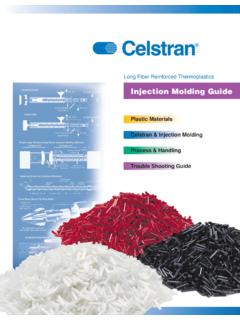
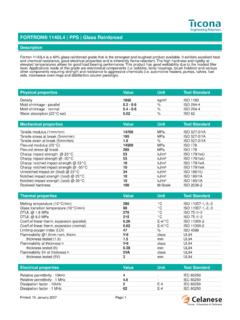
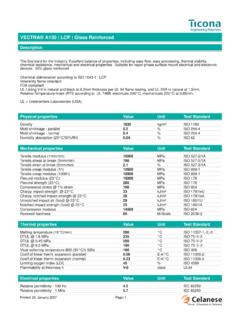

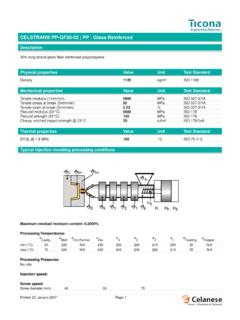
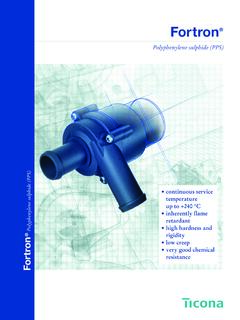

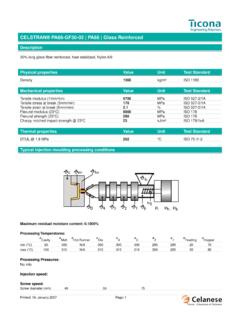


![WELCOME [www.lpsindia.com]](/cache/preview/7/3/4/1/b/7/3/a/thumb-7341b73a085a73e702dcb2a84da66b0a.jpg)

